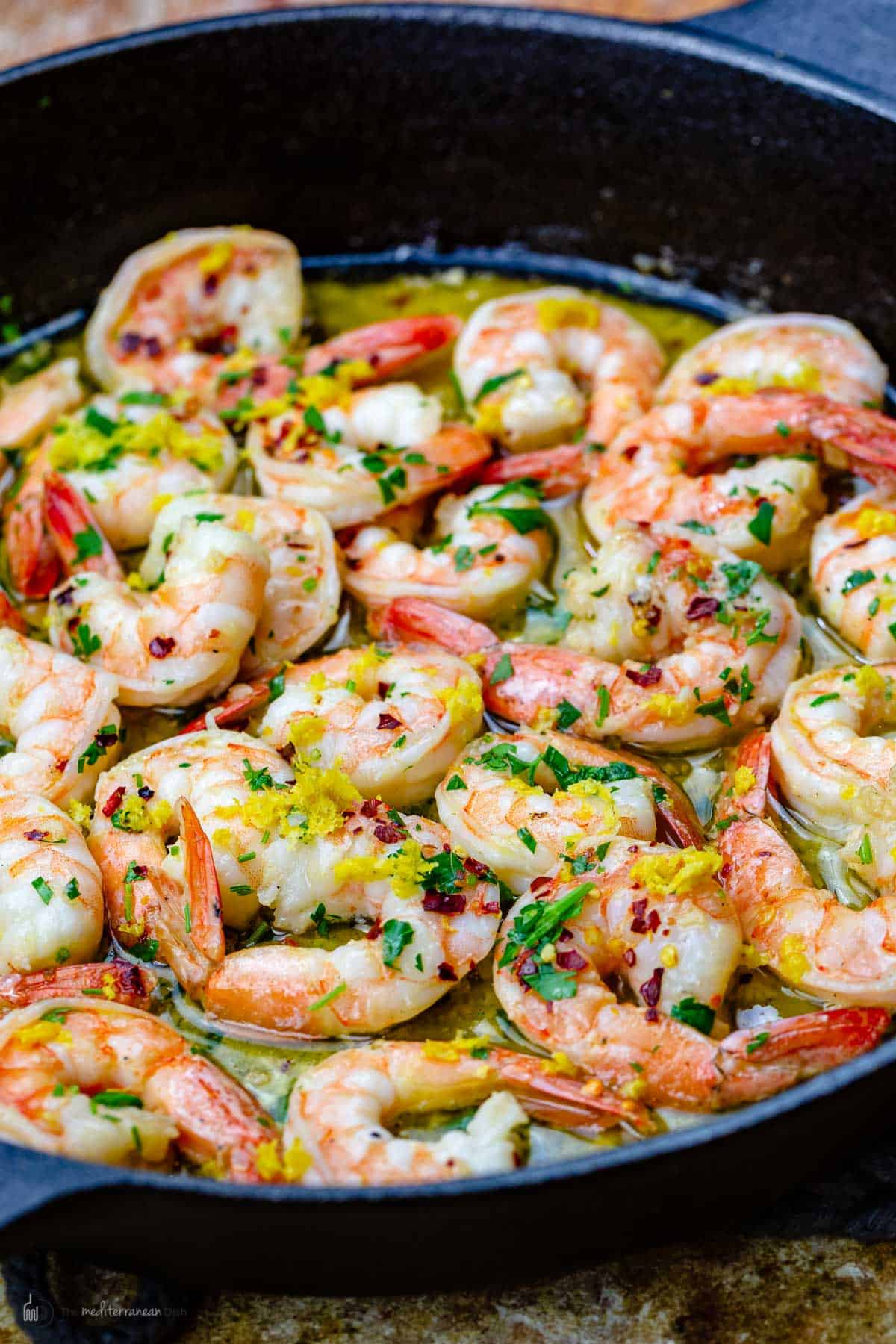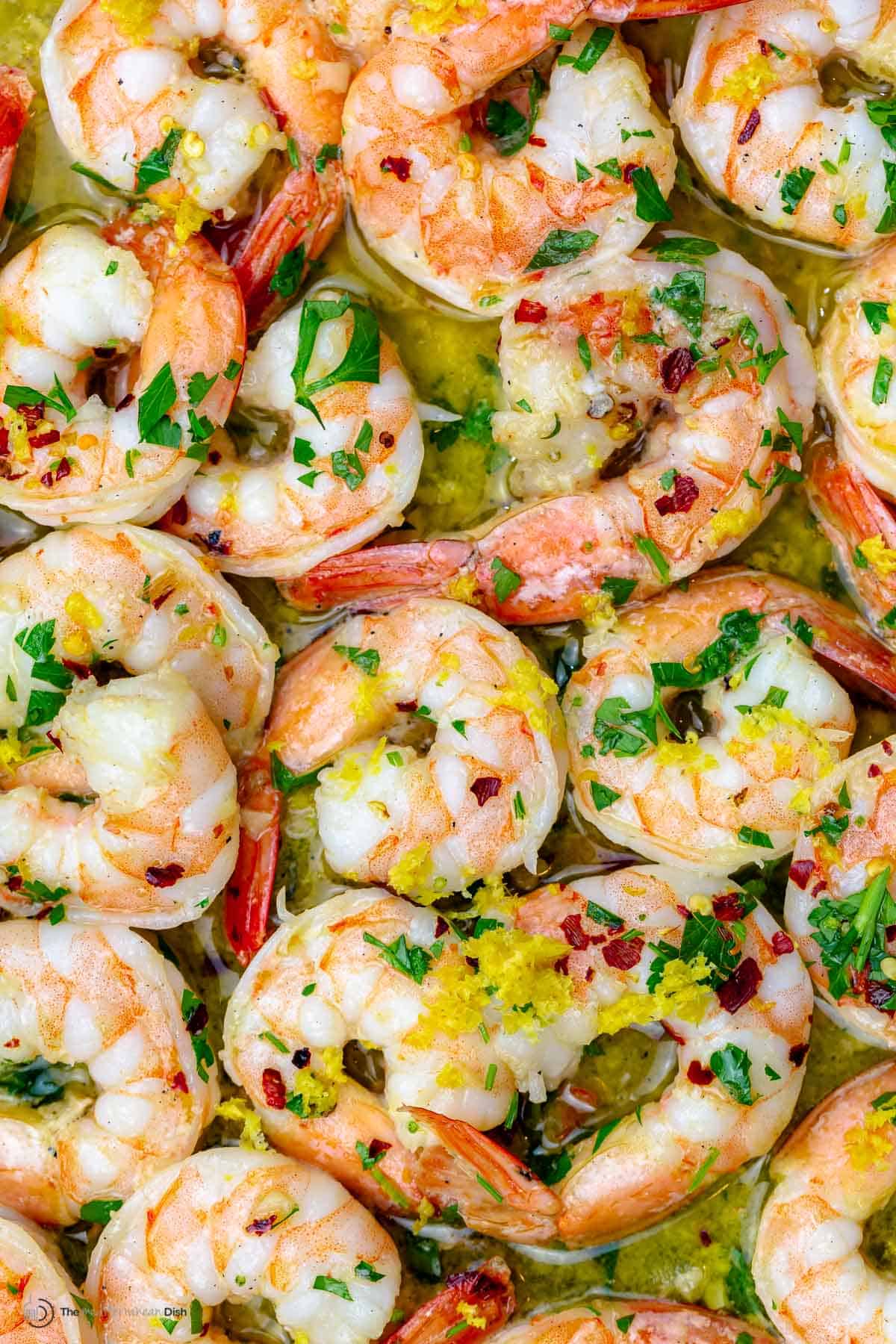There are only a few simple things you need to make shrimp scampi that tastes better than the restaurant version. It only takes 10 minutes and is ready to eat.
Shrimp scampi has become one of the most popular shrimp dishes in restaurants across America. The juicy shrimp soaked in garlic and butter sauce is simply irresistible. However, there is some confusion around what “scampi” actually means in the context of this dish. Let’s break it down and get to the bottom of what makes shrimp scampi so delicious.
The Origins of Scampi
Scampi originates from Italy, where it refers to a specific type of crustacean called the Norway Lobster or Dublin Bay Prawn (Nephrops norvegicus). This creature resembles a small lobster or large shrimp, with strong claws like a lobster but the slender body shape of a shrimp. It lives in the muddy seabeds of the northeast Atlantic Ocean and Mediterranean Sea.
In Italian cuisine, scampi refers to the Norway lobsters themselves The classic Italian scampi dishes highlight the sweet tender meat of this crustacean by cooking them quickly in garlic, butter or olive oil with fresh herbs Some recipes may add white wine or lemon for acidity.
How Shrimp Became “Scampi”
So how did we get from Norway lobster scampi to shrimp scampi? The switch likely occurred when Italian immigrants came to America
Norway lobster is not native to North American waters, so it was not commonplace in American kitchens. However, shrimp share a similar shape and texture to Norway lobster. Both have lean white flesh and a naturally sweet briny flavor.
To recreate the traditional scampi flavors with local ingredients, Italian Americans started preparing shrimp using the same quick cooking methods as lobster scampi. The name stuck, and “shrimp scampi” was born.
Common Preparations for Shrimp Scampi
Today there are a few common variations of shrimp scampi found on restaurant menus:
-
Straight Scampi – Shrimp sautéed in a buttery garlic sauce and splashed with white wine or lemon juice. Sometimes parsley and red pepper flakes add freshness and heat.
-
Linguine Scampi – Shrimp tossed with linguine pasta in the scampi sauce. The starchy pasta soaks up the rich sauce.
-
Scampi Fra Diavolo – Spicy scampi! The sauce gets infused with crushed red pepper flakes or spicy tomato sauce for extra heat.
Tips for Making Shrimp Scampi at Home
Want to make this classic restaurant favorite at home? Here are some key tips:
-
Use large or jumbo shrimp – Small shrimp overcook too quickly. Larger shrimp retain moisture for tender, juicy texture.
-
Cook the shrimp just until pink – Overcooking makes shrimp rubbery. Remove them from heat as soon as they turn opaque.
-
Use a mix of butter and olive oil – Butter adds richness while oil prevents burning at higher heat. For restaurant flavor, don’t skimp on the butter!
-
Cook the garlic briefly – Extended cooking dulls garlic’s punch. Sauté it just until fragrant before adding shrimp.
-
Splash with wine or lemon juice – This brightens all the rich butter and complements the natural sweetness of the shrimp.
-
Serve it hot – Scampi doesn’t reheat well. For best texture and flavor, serve immediately.
Why We Love Shrimp Scampi
While shrimp scampi may not be an authentic Italian recipe, it has earned a beloved place in the American dinner canon. The magic combination of juicy shrimp, bright citrus, spicy pepper flakes, and velvety garlic butter sauce keeps us coming back for more.
It’s also approachable for home cooks since it comes together quickly on the stovetop with minimal ingredients. Served over pasta or crusty bread, it makes an elegant yet easy restaurant-quality meal.
So now that you know what makes scampi “scampi,” it’s time to start sautéing! Just be careful not to overcook those plump shrimp. Buon appetito!

What’s the best pasta to serve with shrimp scampi?
Shrimp scampi is typically served over pasta. Any type of thin long noodles like spaghetti, angel hair, capellini or spaghettini are all good options. Their fine, thin strands go well with the light garlic and butter sauce because the sauce will cover the strands without making them too heavy.
If you love extra saucy pasta, double the sauce portion of the recipe. Or try a twist on this recipe with our Shrimp Cacio e Pepe.
To make it low-carb, you can serve shrimp with garlic and butter over cauliflower rice or zucchini noodles. I also tend to pair dish with a bright and colorful side salad to balance out the meal.

How to make shrimp scampi
Making a restaurant-quality dinner at home doesnt have to be hard. You can make garlic butter shrimp scampi in less than 30 minutes by following a few simple steps. If you have extra time, give the shrimp extra time to marinate. Heres how it goes:
- Prepare and marinate the shrimp. Dry the shrimp off and mix them with olive oil, salt, and half of the garlic. Set aside.
- Cook the shrimp. In a pan with olive oil, cook the shrimp for one to one and a half minutes on each side, until it just starts to turn pink. It’s okay if some of it is still gray; it will finish cooking later. Remove from the skillet and set aside.
- Make the scampi sauce. First, quickly cook the rest of the garlic and red pepper flakes. Then, add the wine and lemon juice. Cook until reduced by ½, then add the butter.
- Add the shrimp. Toss the shrimp in the pan after adding them back in. Let it warm up all the way through and watch any gray shrimp turn pink. When that happens, take the pan off the heat right away.
- Serve Right Away! If you want, you can add extra red pepper flakes, parsley, or lemon zest and serve right away.
Keep these tips in mind before, during, and after cooking your shrimp scampi to make sure it is juicy and full of flavor.
- Use large shrimp. Small shrimp cook too quickly, and it’s easy to cook them too long, making them dry or stiff. So, as I already said, choose bigger shrimp (no more than 20 per pound) if you can.
- Allow the shrimp to marinade. Give the shrimp about 15 minutes to soak up the garlic and olive oil flavor for the best taste. It can even be put in the fridge for 30 minutes while you make a salad or do something else.
- It’s important not to cook the shrimp too long. You want them to turn pink, but not so long that they shrink and become rubbery. So watch your shrimp carefully.
- Serve immediately. Shrimp with garlic and lemon should be served immediately. Remember that the hot sauce will keep cooking the shrimp, so don’t let it get tough.

Garlic Butter Shrimp Scampi
FAQ
Why is shrimp scampi called scampi?
What is scampi made of?
What is scampi sauce made of?
Is shrimp scampi the same as scampi?
What is shrimp scampi?
Shrimp scampi is a variation of the Italian “scampi” dish that substitutes the “scampi” part of the dish with fresh shrimps. The scampi is just another species of crustacean incase you’re wondering. The genesis of this dish is tied with the United States and its early Italian immigrants. Or put simply, the Italian-Americans!
What goes with shrimp scampi?
Most dishes have shrimp, garlic, butter, lemon and white wine; others add in onions, tomatoes, or breadcrumbs. The serving also varies: it’s popularly served with pasta, but it’s not required. Shrimp scampi simply refers to the shrimp and garlic butter sauce, not the pasta. The great part about shrimp scampi: it comes together in minutes!
How do you make shrimp scampi pasta?
Shrimp scampi pasta is a fusion of juicy shrimp and al dente linguine, swirled in a rich, garlicky butter sauce, perfect for a quick, gourmet family dinner. Cook the pasta in lightly salted water according to package directions. Meanwhile, melt butter in a saucepan over medium high heat with olive oil. Add in garlic and shrimp.
Does shrimp scampi taste like pasta?
Shrimp scampi with angle hair or spaghetti is great, the garlicy flavor might remind you of spaghetti aglio e olio, but richer given the addition of butter and shrimp. But if you don’t feel like pasta, then just grab your favorite crusty bread to dunk in the delicious scampi sauce! What is scampi?
